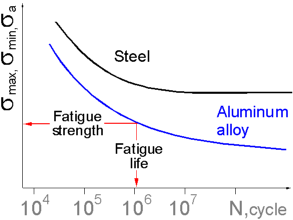 The Fatigue curve or S-N curve is a plot of the number of cycles that a specimen will sustain at various levels of alternating stress or strain before failure. The maximum stress, minimum stress or stress amplitude can be utilized in the plot. A log scale is often used for the N axis.
The Fatigue curve or S-N curve is a plot of the number of cycles that a specimen will sustain at various levels of alternating stress or strain before failure. The maximum stress, minimum stress or stress amplitude can be utilized in the plot. A log scale is often used for the N axis.
The S-N curves of materials such as high strength steels, aluminum alloys or materials in an aggressive environment do not have the horizontal segment.
Fatigue Strength is the maximum stress that can be applied repeatedly for a specific number of cycles without leading to fracture. This quantity is usually determined directly from the S-N diagram.
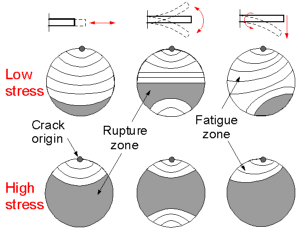 Specimen loading (tension, bending or torsion) and a level of applied nominal stress can be indentified by examining the fracture surfaces. The fatique area has a fine structure outline and occupies nearly the whole section of a specimen if the applied stress is low. Similarly, a specimen which has endured a higher stress displays a smaller fatigue zone and a larger rupture zone.
Specimen loading (tension, bending or torsion) and a level of applied nominal stress can be indentified by examining the fracture surfaces. The fatique area has a fine structure outline and occupies nearly the whole section of a specimen if the applied stress is low. Similarly, a specimen which has endured a higher stress displays a smaller fatigue zone and a larger rupture zone.
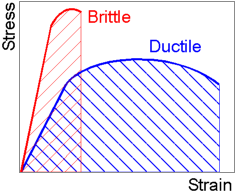 Площадь под кривая напряжение деформация представляет работу, необходимую для разрушения материала. Соответственно, чем больше площадь, тем больше работы необходимые для отказа фирмы. Пластичные материалы имеют обширные пластической деформации и высокое поглощение энергии до разрушения. Пластической деформации и поглощение энергии хрупких материалов являются относительно низкими.
Площадь под кривая напряжение деформация представляет работу, необходимую для разрушения материала. Соответственно, чем больше площадь, тем больше работы необходимые для отказа фирмы. Пластичные материалы имеют обширные пластической деформации и высокое поглощение энергии до разрушения. Пластической деформации и поглощение энергии хрупких материалов являются относительно низкими.
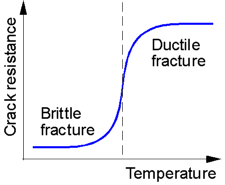 Низкая температура уменьшается способность материала к пластической деформации. Материалы, которые пластичного при комнатной температуре показывают хрупкому разрушению при низких температурах. Исключение, такое поведение является большинство of materials with an FCC structure, which remain ductile at very low temperatures. At a narrow temperature range the crack resistance falls drastically. This is known as the ductile-to-brittle transition.
Низкая температура уменьшается способность материала к пластической деформации. Материалы, которые пластичного при комнатной температуре показывают хрупкому разрушению при низких температурах. Исключение, такое поведение является большинство of materials with an FCC structure, which remain ductile at very low temperatures. At a narrow temperature range the crack resistance falls drastically. This is known as the ductile-to-brittle transition.
|
|
|
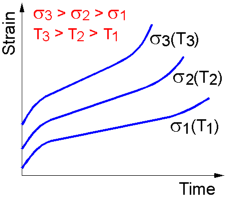 Creep is the gradual increase of plastic deformation of a material under a constant stress, which is less than the yield stress. Creep is pronounced at temperatures above 0.4 of the melting point (taken in oK). The greater the service temperature or applied stress, the less time the material takes to fracture due to creep.
Creep is the gradual increase of plastic deformation of a material under a constant stress, which is less than the yield stress. Creep is pronounced at temperatures above 0.4 of the melting point (taken in oK). The greater the service temperature or applied stress, the less time the material takes to fracture due to creep.
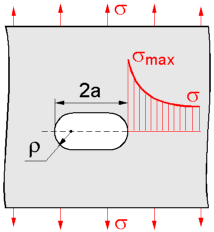 The maximum stress, near the tip of an elliptical opening, perpendicular to the applied stress in a plane is determined from the following:
The maximum stress, near the tip of an elliptical opening, perpendicular to the applied stress in a plane is determined from the following:
smax = s x [1 + 2 x (a/r)1/2]
where s is the applied stress; r is the radius of curvature at the tip; a is the half length for an internal opening and the full length for a surface opening.
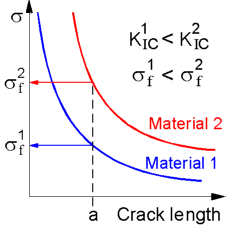 Critical stress intensity factor KIC or fracture toughness demonstrates the resistance of a material to the crack propagation. Damaged materials with higher fracture toughness can sustain a higher stress.
Critical stress intensity factor KIC or fracture toughness demonstrates the resistance of a material to the crack propagation. Damaged materials with higher fracture toughness can sustain a higher stress.
The maximum nominal stress that a structural element with a crack can sustain, is determined as:
s = KIC / [Y (p x a)1/2]
where a is the half of the crack length; Y is a dimensionless factor depending on geometry. For a through internal crack that is much smaller than the dimensions of the element Y=1, for a surface crack Y=1.12.
 2015-08-13
2015-08-13 483
483








